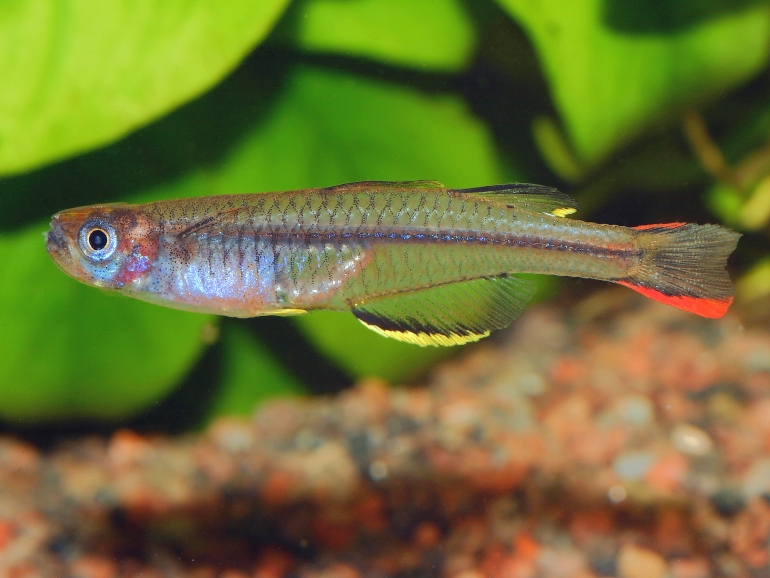|
 |
Pseudomugil novaeguineae - photo© Hans Herbert Boeck |
Weber, 1908
New Guinea Blue-eye
Species Summary
Pseudomugil novaeguineae have a yellowish semi-translucent body with a thin dark mid-lateral line on the sides. The body scales are lightly edged with black forming an attractive latticework pattern. Common maximum size for this species is about 45 mm SL. Males have elongated anterior first, second dorsal and anal fin rays. Adult males have a red first dorsal spine and the outer margin of the first dorsal fin is also red. The second dorsal and anal fins, as well as the lower lobe of the caudal fin have white or yellow margins. The colour can change rapidly back and forth between white and yellow. The adult male can also be recognised on the blackish anterior edge of his dorsal fin and the black streaks that adorns both the upper and the lower edge of the caudal fin. Specimens collected from the Fly River in New Guinea have been reported as having a transparent body with glistening bluish or violet colour on the head and abdomen. The eye has a faint gold ring around the pupil with the iris silvery or faintly blue. The second dorsal fin of males is either clear, as in females or carmine red. Reddish coloured eggs are laid by Pseudomugil novaeguineae.
Distribution & Habitat
This species has patchy distribution in central southern New Guinea between the Fly River, Papua New Guinea and Etna Bay, West Papua. They have also been collected from the Aru (Aroe) Islands in the Arafura Sea. Scientific specimens of this species were first collected from the Lorentz (Noord) River by Hendrikus Albertus Lorentz during the Dutch Expedition to New Guinea in 1907. Lorentz participated in three expeditions to Dutch New Guinea. The first expedition was in 1903, led by A. Wichmann. Lorentz led expeditions in 1907 and 1909-1910.
Pseudomugil novaeguineae inhabit small clear rainforest streams; well shaded but with occasional open patches exposed to sunlight. A temperature of 24° Celsius and pH 7.8 were recorded at one collection site in a tributary of the Ok Smak River, about 35 kilometres north of Kiunga. Kiunga ballochi sometimes occurs in the same streams.
Remarks
Around 1976 live specimens were collected and sent to Germany and again in 1989. In 2004, Iain Wilson and Charles Nishihira collected live specimens of this species from Kali Iwaka (Deky Creek) and Kali Kopi in the Timika-Tembagapura region of West Papua. There have been a number of other collections, but Pseudomugil novaeguineae is still not widely available in the aquarium hobby.
Literature
Allen G.R. (1991) Field guide to the freshwater fishes of New Guinea. Christensen Research Institute, Madang, Papua New Guinea.
Allen G.R. (1995). Rainbowfishes in Nature and in the Aquarium. (Tetra-Verlag: Germany.)
Allen G.R., W. Ivantsoff, M.A. Shepherd and S.J. Renyaan (1998) Pseudomugil pellucidus (Pisces: Pseudomugilidae), a newly discovered blue-eye from Timika-Tembagapura region, Irian Jaya. Aqua 3(1):1-8.
Weber M. (1907). Süsswasserfische von Neu-Guinea ein Beitrag zur Frage nach dem früheren Zusammenhang von Neu-Guinea und Australien. In: Nova Guinea. Résultats de l'expédition scientifique Néerlandaise à la Nouvelle-Guinée. Süsswasserfische Neu-Guinea v. 5 (Zool.) pt 2: 201-267, Pls. 11-13. [Also as separate, E. J. Brill Ltd, Leiden.]
Adrian R. Tappin
Updated December, 2008



|

